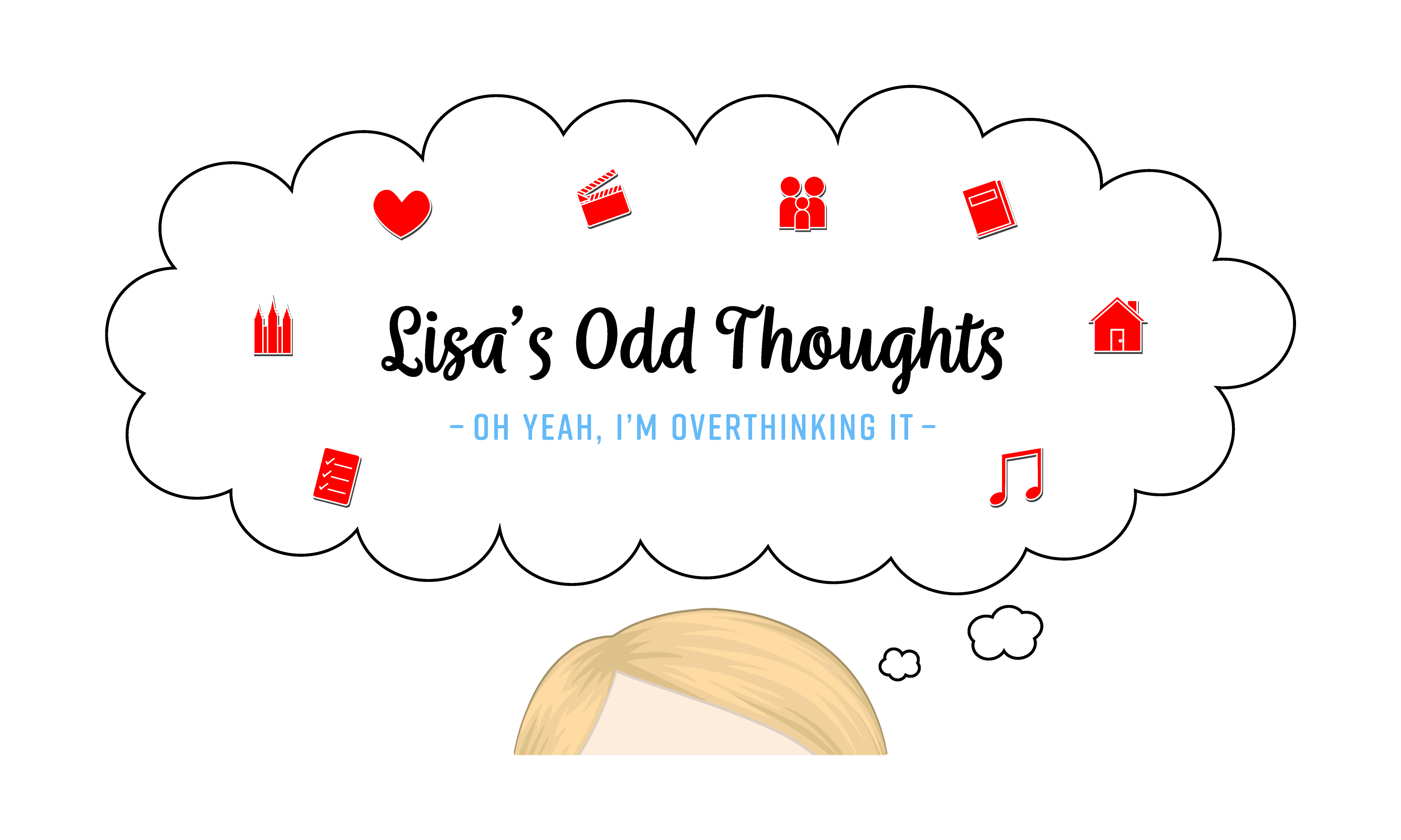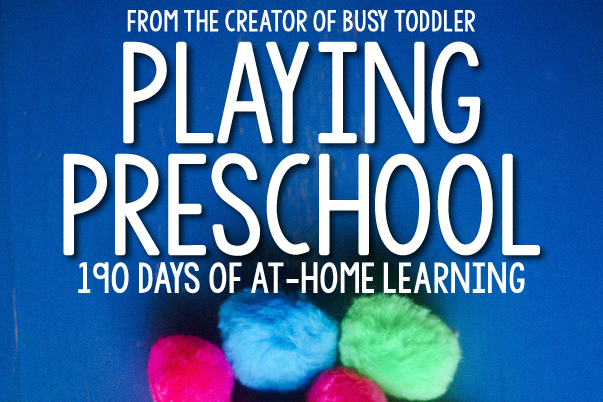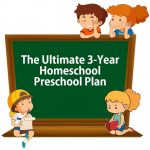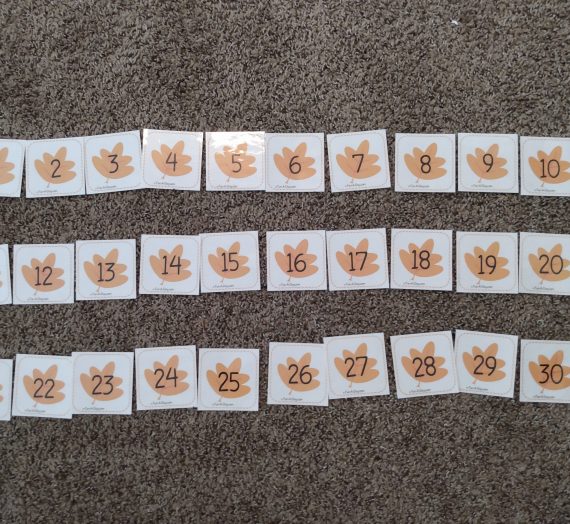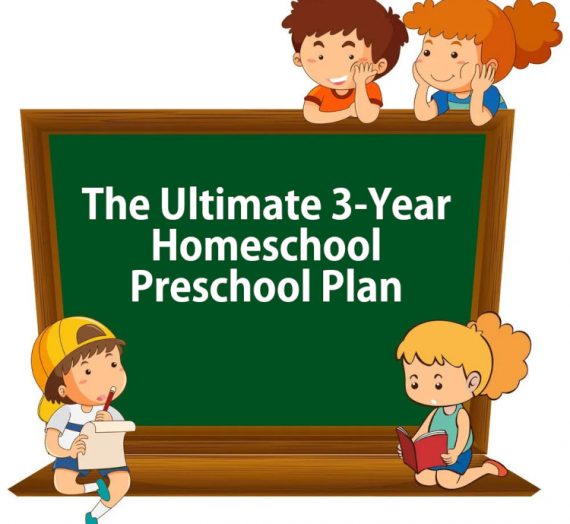At the beginning of 2020 I began Pre-Preschooling my toddler boys, then ages 3 and 2. I called it Pre-Preschool because we did very simple, play-based activities that introduced the concepts of letter sounds and counting, but we didn’t actually do formal lessons, reading, math, or other academics. It was Pre-Preschool, remember.
Instead we did Pre-Preschool with a daily Calendar routine, a Learning Board, and easy Letter-of-the-Week Activities. Click the links to find out how I taught each of these three aspects of our Pre-Preschool.
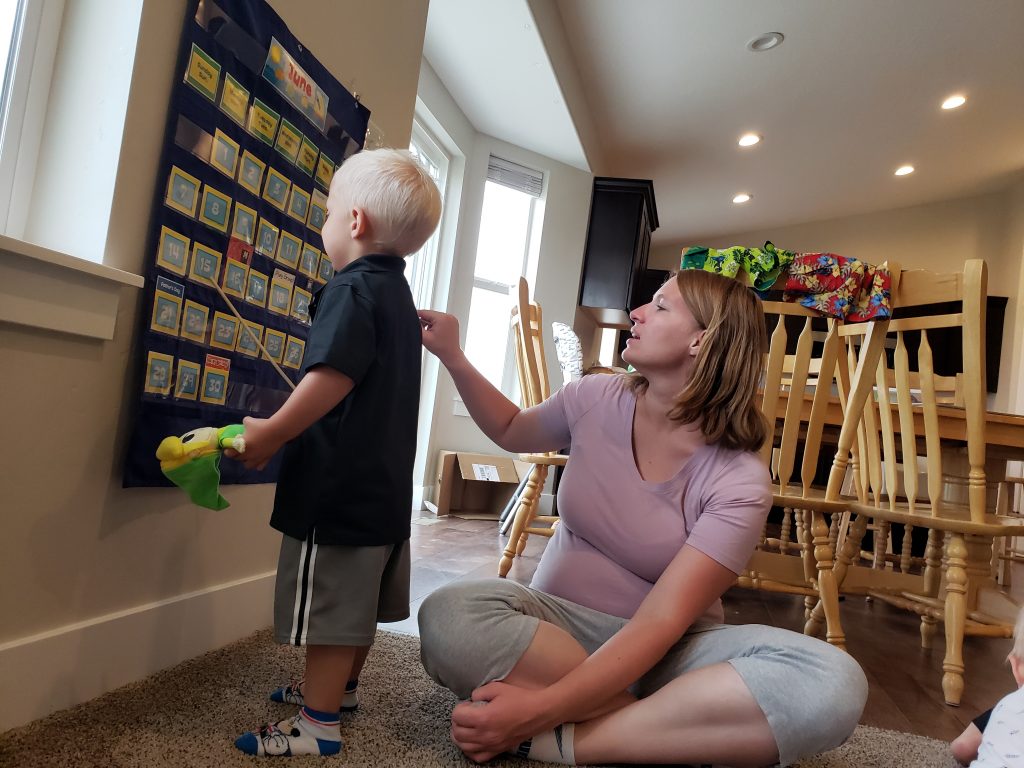
Pre-Preschool was designed to be a fun introduction to learning, and it was! My boys loved it!
Pre-Preschool took us 26 weeks plus two vacation weeks, so we finished in July, which is also when my 3-year-old turned 4. Pre-Preschool was a big success, but I knew that my now 4-year-old was ready for more. He really enjoyed the mental stimulation of learning new things and was constantly asking for more, more, more!
And so during our “summer break” of August, I researched and bought this at-home preschool curriculum from Busy Toddler called Playing Preschool and I’m here today to tell you all the ins and outs and to give my honest review of Playing Preschool.
This is the link to the Busy Toddler website and the Playing Preschool curriculum. You can check it out for more details.
Spoiler Alert: I think it’s great. It’s not flawless, but we’ve enjoyed this program so much and my boys love doing Preschool!
But let’s not get ahead.
There are lots of homeschool-preschool activities and curriculums out there, but this one stood out to me for a few reasons.
First, it’s all play-based. No worksheets, no drilling or memorizing, and no rigorous hardcore academics. This play-based approach was very important to me.
Second, it was already done and planned and ready to go. I very seriously considered creating my own homeschool-preschool program; after all, that’s exactly what my Pre-Preschool was, and doing that gave me the confidence to push forward and do more complex and academically-based activities with my boys. But I didn’t really want to do more. I didn’t see a great need to reinvent the wheel and give myself just one more thing on my To Do list.
Third, it was organized similarly to what we’d already been doing. It encouraged a daily Calendar routine and a Letter-of-the-Week. But then it had more, which is exactly what we needed. Each letter was studied with a themed unit, learning about apples for Aa, transportation for Tt, clothing for Cc, farm for Ff, etc. This added boost of a themed unit really sold it for me and was just what my 4-year-old needed for some further engagement.
Fourth, it included great early math skills, which is my weak area. Letters, literature, and reading I’m all about. Yes, yes, yes! But math? No thanks.
It’s not that I’m bad at math, not at all, it’s just I never enjoyed math. So how on earth does one make math fun and interesting for a toddler? Beats me; it was never fun and interesting to me at any age. Further, what do you even teach as early math skills? Addition? Fractions? Long division? I seriously had no idea. But Playing Preschool emphasizes all sorts of great, early math concepts that never would have even crossed my mind: graphs, 10-frames, measuring, and sorting. And of course number recognition and counting.
Fifth, it was on sale! Busy Toddler had a Covid sale for all these new homeschoolers and distance learners, myself included. How could I possibly say no to that?
So I bought the two-year program, gathered our supplies, organized a preschool space, and off we went with Playing Preschool! We began immediately after Labor Day and began our daily Preschool.
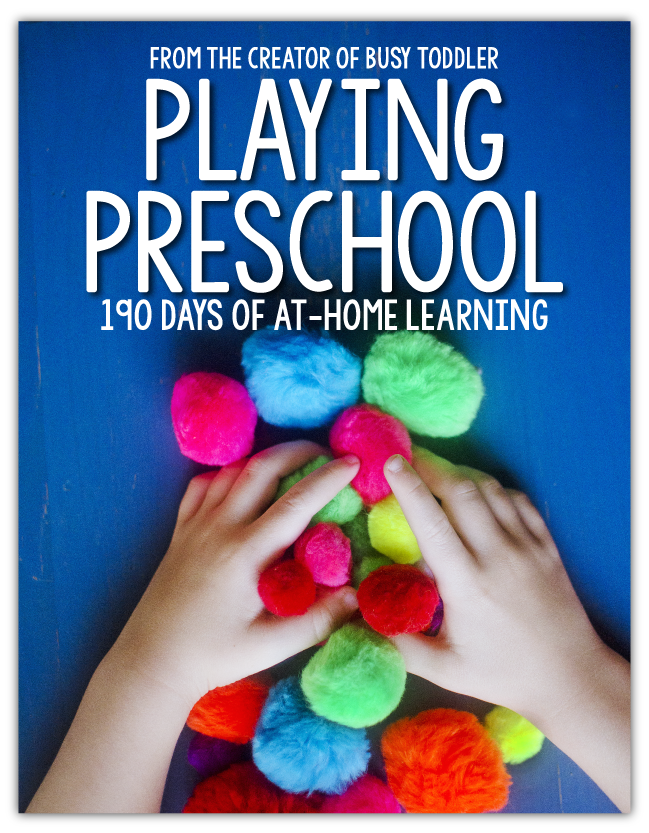
Overall I highly recommend this program, but I have to be perfectly honest: we had a rough start. It took me about a month to get into the groove of things, and those first couple units were a bit of a struggle. So I’m going to start here by telling you the things I don’t like about Playing Preschool, including why we struggled at the beginning. But don’t get discouraged and keep reading to also find out what I love about this program.
Things I Don’t Like about Playing Preschool
The Units are 2 Weeks, Which is Too Long
Playing Preschool is divided into units, as I previously said. The first unit is Apples (learning Aa) and the second is Colors (learning Rr for rainbows). Each unit is designed to take two weeks.
Turns out that two-week units were WAY too long for us. Especially after our own Pre-Preschool program had worked focusing on one-week letter themes, my boys were confused and upset when on that second Monday I had to explain that we were staying on Aa for apples. They weren’t very pleased and that second week of Unit 1 was hard. They were bored of apples and I lost their attention and enthusiasm for it very quickly into that second week.
Further, the topic of apples itself just doesn’t lend to a whole lot of games and activities. Apple books are limited, and we breezed through all the suggested reading material within the first few days of that first week. We were excited and eager for it all then, but like I said, we lost all our apple enthusiasm after that first week.
When we came to the second unit, Colors, we got back into our excitement again. Colors are way more fun to learn about that apples, if I do say so myself, and naturally lead to a lot more books, activities, and fun art projects. My boys loved all the color mixing and sorting games and we had a blast.
Our second two-week unit, however, was cut short. We had a family vacation planned for the later half of the second week, which I of course knew about ahead of time and planned for. Therefore, I packed the ten days of Preschool into only seven. At first I was super worried about this, but to my pleasant surprise it worked perfectly, so perfectly that I decided to next try condensing it all into one single week.
So for Unit 3 (Nursery Rhymes studying Nn) I rearranged the schedule and combined the two weeks into one. We did two-days’ worth of activities every day instead of one and it worked perfectly. We’ve kept the model ever since and it’s worked wonders.
Now I have to add a big disclaimer to this “condense the two-week units into one single week” idea:
There are a handful of units that emphasize two letters that week instead of one. During the Clothing unit we learned Cc for clothes and Jj for jackets. During Weather we learned Ww for weather and Kk for kite. And so on. There are 26 letters of the alphabet but only 19 units, so that means there are seven such units with two emphasis letters (check my math; remember, I’m a reader, not a mathematician) .
The first two-letter unit we did was Clothing, emphasizing both Cc and Jj. And I was fully in the routine of condensing everything into one week, but it didn’t work so well that week. The curriculum suggests emphasizing the Cc during Week 1 and the Jj during Week 2, but I didn’t do a Week 2. We did a few Jj activities and decorated our J’s with jewels, but I felt like Jj was really overshadowed and that unit as a whole wasn’t nearly as effective as I would have liked because of it.
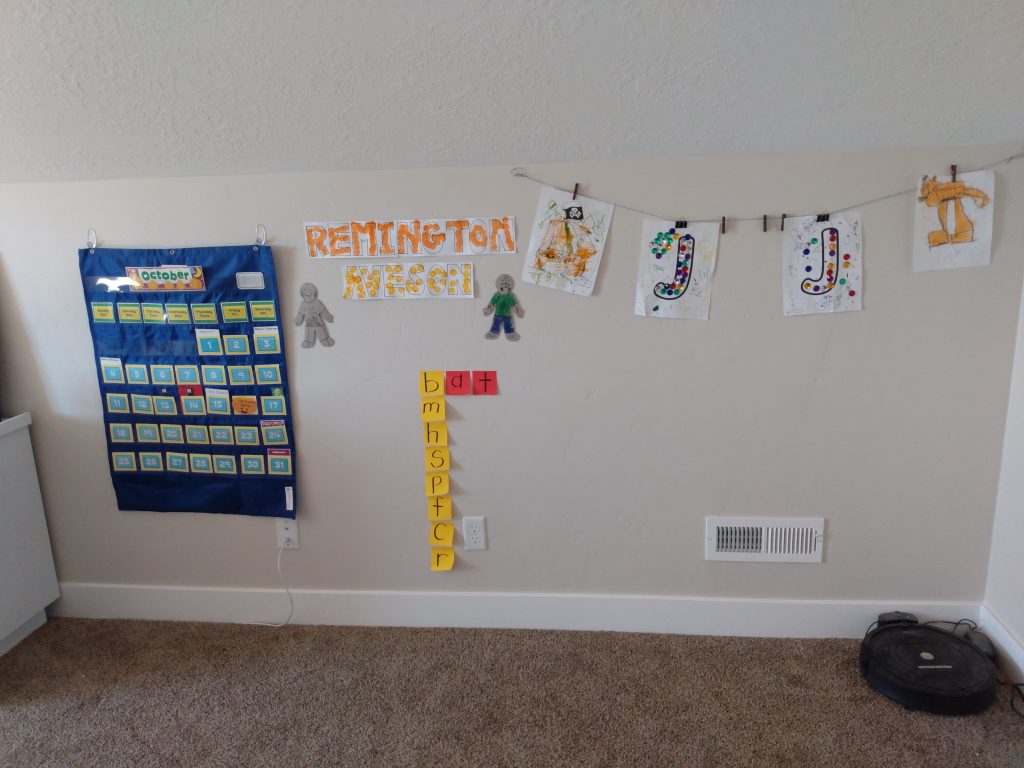
So the next time we came to a double-letter unit, I didn’t condense down to one week but stayed with the two-week system. I dipped a lot more into my old Pre-Preschool activities to pad the extra time, but that’s just fine. It worked much better for us and my boys didn’t even notice, as I still updated the Learning Board that second week to learn the second, new letter. And it all worked beautifully.
Some Activities Are Too Easy.
Playing Preschool is advertised for ages 2 1/2 – 5. As my boys were 2 and 4 at the time we began, I thought we were all set. But it turns out that my 4-year-old was way too advanced for many of the activities, while they suited and entertained my 2-year-old perfectly.
This honestly might be due to the fact that we’d just finished our Pre-Preschool, so my boys (especially my 4-year old, who retained much more of our Pre-Preschool than my 2-year-old) were already familiar with their basic letters and numbers.
For example, Playing Preschool only teaches and emphasizes the numbers 1-5 for the first few units. When they finally bumped that up to numbers 1-10, the program made a big emphasis on not pushing your child up to ten until they had mastered and were comfortable up to five.
Seriously? Both my boys have been able to count up to 29 for ages (30 is really hard for my older boy, for reasons I don’t know. He’ll get counting, “27, 28, 29, 20-10, 20-11, 20-12,” etc. We’re working on it. I wonder if I also confuse him by telling him the year is “twenty-twenty” and then “twenty-twenty-one.” But who really knows). So sticking with 1-5 was really boring for both my boys. The program still hasn’t moved past 10, and my older boy regularly asks when we’ll do 11 and 12.
Speaking of some things being too easy, that also means that we finish some activities way too fast. I still remember that very first day of Unit 1. We followed the little script, read an apple story and talked about the concepts, breezed through the two apple activities…and we finished in about 25 minutes.
For some reference, the program suggests that every day will take about 45 minutes.
So I just kind of sat there blankly with 20 extra minutes to spare and my sweet boys, who’d thoroughly enjoyed our fun but short preschool day, began asking, “What’s next? What’s next? I want more! What’s next?”
“Nothing,” I felt sad to tell them. “That’s everything for today.”
Unfortunately this was the norm for those first two units (another good reason to combine the two-week units into a single week). Every day they wanted more, more, more! So I invented more, more, more. Mostly I dipped back into my old list of Pre-Preschool ideas and we redid many of our A-themed activities (even though they didn’t have anything to do with apples).
But even after we combined weeks, some activities were still too easy, fast, and therefore boring for my 4-year-old. Like I said, my 2-year-old loved all of it, every single thing. Just keep that in mind if you’re looking at this program for older vs. younger toddlers.
Note: yes, the program advertises that the activities and lessons are progressive, meaning that they’ll get harder and more complex throughout the program. So yes, you might argue that the first few units are supposed to be extra easy. That aside, we’re almost done with the first year and we still find activities that are way too easy for my oldest.
I Hate Picture Walks…And So Do My Boys
Every now and then I’ll come to an activity that I super don’t want to do with my boys, either for the mess or because I know they won’t like it. Picture walks are one of those things that I always skip every single time because I hate them so much.
If you’re not familiar with a picture walk, I’ll explain. For some reason there is this academic idea floating around in the world to give this sort of “preview” of a book to a child via a “picture walk.” This simply means that instead of actually reading the book, you simply look at the pictures page by page and discuss them. I think it’s supposed to encourage skills like predicting and making inferences.
But I hate it.
I actually remember doing picture walks in elementary school. I remember sitting on the rug and the teacher would flip through the pages and try to discuss it with us. I hated it because I felt like it gave away the ending of the story. Why on earth would I want to just look at it instead of reading the darn thing already?
The Playing Preschool program, unfortunately, puts a big emphasis on picture walks, usually spreading the picture walk an entire day away from actually reading the story.
I was super skeptical, but I decided to give it an honest go on that first day…and it did NOT go over well. I read to my boys all the time, so they were confused and angry that I was just talking to them instead of reading. We didn’t even make it through the entire book before I could sense a big tantrum coming on; they expected me to read them a stinking story, after all, and they weren’t happy that I was going so far off the beaten path. I can only imagine the meltdown that would have occurred had I then put that book away and said, “We’re done with this for now; we’ll read it tomorrow!”
No.
No, no, no. No.
That was the one and only time I tried that dreaded picture walk with my boys, and since it failed so miserably I’ve given up on the idea entirely. Still, it is a suggested activity nearly every other day in the Playing Preschool program, and I always skip it completely.
I Also Don’t Like Sensory Bins
This one is entirely personal and isn’t necessarily a flaw in the program, just my own preference.
I’ve tried various sensory bins for my boys over the years. I truly have.
And I hate them. Every. Single. Time.
It doesn’t matter how big of a box you get for them to dig around in. It doesn’t matter what material you fill it with. It doesn’t matter how many toys and shovels and whatever else you give them to use.
Sensory bins are a mess. No matter what.
I have enough messes to clean up. I don’t need nine million pieces of rice tracked around my house for the next three months just because Pinterest suggested a freaking Rainbow Rice Sensory Bin. Oooooohhh! Pretty!
No. No. No. No. NO!

More than just the messes, my boys were never very entertained by sensory bins. They’d play for a few minutes and then inevitably get bored and start dumping the rice on the floor instead. So glad I spent an hour arranging this cutesy little box for you!
So I banned sensory bins from my house, especially from the inside of my house.
I once discussed my sensory bin ban with a good friend who studied child development in college. I told her that I worried I was depriving my children of some vital skill or experience by banning sensory bins, because after all, they’re ALL OVER Pinterest and everyone swears by them, so surely don’t they provide some sort of good that I’m denying my children, right?
I loved her answer. She explained that sensory bins are a very recent solution originally designed specifically for sensory-sensitive children (such as kids with autism or something else in that realm of sensitive). Further, she told me this: “Being outside is the ultimate sensory experience for a child. There’s grass, wind, leaves, sounds, bugs, dirt, smells, uneven ground, trees, all that stuff. So if you want to give your kids a sensory experience that’s not in a bin, just send them outside.”
I felt much more justified in my dislike of sensory bins after that conversation. And yes, I try to get my boys outside often.
And then I got the Playing Preschool curriculum. And it’s rife with sensory bins all over the place. Not every single unit contains a sensory bin, but enough do that it irks me. And guess what? I skip it every single time.
The very first unit, for example, suggests doing an applesauce sensory bin and mixing a bunch of applesauce with various food coloring for your kid to play in. I opted out of that one immediately, horrified of the sticky applesauce handprints that would inevitably end up all over the table, chairs, and floors if we did such a thing. Besides, my kids know, eat, and love applesauce regularly; putting their hands in a bunch of applesauce isn’t going to change that or give them some enlightening new insight into the world of apples.
Further, in my own experience with sensory bins, they’re better for smaller kids. Remember I said that some activities were too easy for my older son; sensory bins fall under that category. Sensory bins work better for older babies who need a little hands-on activity to keep them entertained while Mom gets some work done. (Again, this is my opinion only, and please don’t give your baby a sensory bin filled with millions of little choking hazards, like uncooked rice or beans, just because I said this.)
If you and your kid love sensory bins and if you read that idea about an applesauce sensory bin and were overcome by a feeling of excitement rather than dread, well then, my friend, you’ll love this Playing Preschool program.
Playing Preschool Isn’t Designed to be Very Flexible
Basically I had to force it into flexibility, but that means I take a lot of creative liberties with the whole thing.
Playing Preschool is designed to happen five days a week and it follows a similar routine every day: read a book (or do a picture walk, if you’re not a grump about them like I am), have a discussion, and then do two learning activities. Done.
There is little wiggle room for skipping days or activities, or adding your own ideas should you so choose.
Like I said above, I had to force some flexibility into our Playing Preschool schedule. Firstly, obviously I combined the two-week units into one, as I already described.
Secondly, we don’t do Preschool every single day. At least one day a week we spend with our weekly playgroup or with my mom, and on those days we simply don’t have time for Preschool. And you know what? There are simply some days when routines are off, kids get sick, other necessary errands crop up, boys are cranky (or Mama is cranky!), or maybe the weather is just too nice outside and we went to the park instead! Typically we officially do Preschool about three or four days a week, not the suggested five. But all of that condensing and skipping means that we inevitably don’t have time for every single thing that the unit suggests. Sometimes that’s okay, but sometimes I kick myself because we just didn’t have time for that one awesome thing, but we of course just keep pushing forward to the next unit.
In the name of forcing flexibility, I’ll describe to you what our typical Playing Preschool unit looks like.
On Monday morning I go through the curriculum, theme, and books for the week.
(Note: I do indeed look at the units well beforehand so I can get a hold of the suggested books. It was a suggestion by the creator to put books on hold at the library for at least two weeks in advance, and I’ve learned the hard way to start collecting books at least three weeks in advance. I also use my mom’s book collection as our own personal library for any books relating to our theme, suggested or otherwise.)
First thing in the morning I update our Learning Board with new flashcards for the week. Then I read through the entire two-weeks’ themed unit and write out on a separate sheet of paper all the activities that I know that my boys would like to do. If they coordinate with a particular book, I note that too. Sometimes that list is very long and we do most of the suggested activities. Sometimes, I’ll be perfectly honest, that list is shorter than I’d like.
I also review our old Letter-of-the-Week activities and see if there are any old activities that already match the unit’s theme, or were particular favorites that my boys would like to repeat, or if there were some activities we weren’t able to get to. I add all of that to my list as well.
Then we sit for Preschool. We of course start with our Calendar (as suggested) and Learning Board, and then I introduce the new unit for the week. We often start with a discussion. For example, we just finished the unit about Eggs (for the letter Ee) and that very first day we discussed what my boys already know about eggs (we have eggs in our fridge that we eat). “Well do you know that lots of other animals also lay eggs?” and then we talked about birds, reptiles (and what the heck a reptile actually is), and fish are all creatures who lay eggs. We repeated this conversation, with some variants, throughout the week.
Then I look through my list and pick some activities for the day. Sometimes my boys want to do just one (some activities are longer, so that’s okay) and then get tired (this is also okay, as the curriculum smartly and regularly suggests to be watchful for fatigue in your child; this is supposed to be fun, after all, and if it’s too long or boring or overwhelming then it’s no longer fun).
Or on other days, when we’re having a really good time, my boys ask for more, more, more, more! Then we just move down the list I made and do as many as they ask for or as many as we have time for.
Remember I had this issue on our very first day back when we did Aa for Apples and we finished the entire thing in 25 minutes. I learned from that mistake to have the extra activities ready just in case my boys ask for more. So having a handy list right there is really helpful to glance through when needed.
We usually read books at the end of our Preschool routine, even though the curriculum suggests you do so first. This isn’t a must for us, but it’s the habit we fell into. Usually I find that my boys are even more excited to read a book about eggs after we’ve discussed the kinds of animals who laid them and made some egg art project. Plus it’s a good winding-down activity to end things on, especially as my youngest one-year-old (who eagerly joined our little Preschool about halfway through our schoolyear) has naptime immediately following Preschool and my older boys have quiet time.
Speaking of reading books, I love that Playing Preschool offers a booklist for each unit. But I don’t read them in the order that the curriculum suggests (and I don’t do picture walks, either, remember). I keep all that week’s books in an open bin and when its time to read together, my boys can peruse everything and choose whatever strikes their fancy. It gives them a bit of a feeling of control that I encourage. Unless, of course, we’re doing an activity that specifically matches a particular book, which happens frequently throughout the curriculum.
With all this in mind, sometimes you might look at our very flexible routine compared to Playing Preschool’s very specific routine and think, “She’s hardly following the curriculum at all!” I disagree, to an extent. Yes, I’ve been using this curriculum as more like guidelines than actual rules, but I’m still following and loving it…just in my own, very flexible way.

Things I Love About Playing Preschool
The Booklist!
As I mentioned above, each themed unit comes with a suggested booklist. I don’t always get every single book from the library in time for our unit, but both my boys and I have loved reaching out of our normal bookcase and finding new books to read and love.
A particular favorite that we were introduced to through this curriculum was Harold and the Purple Crayon (during the Color unit), which my boys loved so much that we renewed it over and over, and they were still sad to finally send it back. Imagine how extra thrilled they were when their grandma gave them an entire boxed set of Harold books for Christmas!
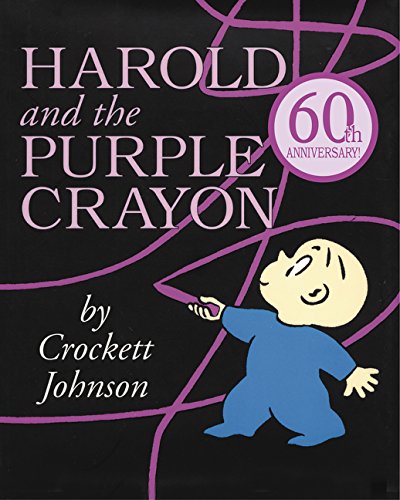
Besides that we’re being introduced to new reading material, it’s nice to have the list already there and ready. I don’t have to sit and wonder, “Hmm, the unit is Color. Do I have any color books?”
Like I also said above, I not only use the suggested book list, but I also use our own books as well and I borrow kid books from my mom just as often. Familiarizing my boys to her books has opened up a whole new part of Grandma’s house for my boys and they love running to her bookcase and picking out books, especially ones they read and loved in past units. Further, my best friend so happens to be an ex-elementary school teacher and she always has great suggestions for books to match our units, either that she can lend me or for me to look for at the library.
Basically my boys and I love reading together and this Playing Preschool curriculum has opened up way more book options than just what we own ourselves.
Pro Tip: I’ve learned that just about every picture book out there has a read-aloud video that someone has made on YouTube. There are whole YouTube channels dedicated to reading picture books, like reminiscent of good ol’ Reading Rainbow. If there is a book that our library doesn’t carry, or maybe if I didn’t get it in time, we open up the old computer and watch a read-aloud video of it. And my boys love it!
Decorating the Weekly Letter
The curriculum comes with a printable of all the alphabet letters, just one big blocky letter on a single page. And then every week you decorate that letter with something that begins with its sound, and usually with something that correlates with that week’s unit.
For example, for the Food unit we studied the letter Mm (such as, “Mmm, that tastes so good!”) and we glued marshmallows all over our M’s. And my boys of course ate a great deal of those marshmallows too.
Besides that my boys SUPER look forward to decorating their letters every week, the curriculum suggests keeping all your letters in a three-ring binder, which we do. And every week we open that binder to add our new letter and review all the other letters inside. My boys always enjoy looking through their letter books and it’s a really great review for us to flip through it. I always verbalize, “Here’s A for apples, B for buttons,” and so on. “And now we’re adding K for kite!” And they love it.
I mentioned that my one-year-old recently has joined our Preschool. He’s still too young for learning letters, but it was decorating our letters that he was first interested in. So yes, I’ve started printing him his own letters and then I put down the glue and he’s learned to press whatever we’re using onto it. He absolutely loves it, and I think he also loves sitting at the little table with his big brothers and feeling included. Whatever the reason, it holds his attention and makes him wonderfully happy.
It’s great motor skills, creativity, and letter review all rolled into one! Yes, yes, and yes!
It Offers Great Review
One thing that my Pre-Preschool routine was lacking was any kind of review. We did our weekly letter, but then we moved on and never looked back.
This curriculum though, always has at least one review activity that includes all the letters previously learned. Often it includes matching the lowercase to the uppercase letters.
For the Hh unit we learned about community Helpers and one day we played firefighters to review our letters; I wrote with a dry erase markers all the glass door of my shower and then my boys squirted the letters away with a squirt bottle…and of course named each one before doing so. It was a huge hit and my boys loved it.
The Easy Math Skills
I already mentioned this one above but it’s worth repeating, even quickly.
I honestly would have had no idea what kind of math to introduce to preschoolers or how to do it. But Playing Preschool makes these early math concepts not only easy, but really fun! My boys always enjoy measuring things and especially love rolling objects down ramps to measure the distance they roll (which we did with apples for Aa and Easter eggs for Ee). They’ve also mastered 10-frames, which we review often, and we always emphasize that a 10-frame has five frames on both sides, that kind of stuff.
Good work, Playing Preschool. I commend your early math introduction!
The Activities/Supplies are Generally Easy to Gather and Prep
The beginning of each unit has a supplies-needed list, which I always look through, obviously. Even more, the curriculum itself has a Most-Used Supplies List which I gathered before we even began our first unit. So setup is super easy as I almost always have everything I need right in our box and ready to go.
If I don’t already have a particular necessary thing, at least they’re cheap and easy to come by. Cotton balls, for example, are a really common art supply that I don’t keep in our preschool box, but I do keep in my house. We decorated Mary’s little lambs with cotton balls when we did Nursery Rhymes (Nn) and we made cloud art with cotton balls for the Weather unit (Ww).
Besides supplies, most of the activities don’t require tons of prep. There are a few exceptions, of course (such as sensory bins–another good reason to skip them), but for the most part I can set up activities as we are doing them. I’m not up the night before prepping elaborate crafts or anything like that. Most of the time we can just go for it.
And I appreciate that for sure.
Having a Themed Unit Directs our Activities and Discussions in the Best Way
Remember how I said that my oldest always wanted more, more, more? This curriculum definitely placated his little desire and I believe it’s totally due to the units being themed.
When we did our Pre-Preschool, we usually did more of a broad overview of that weekly letter. For Ff we indeed talked about farms, which is the theme for Playing Preschool’s Ff week, but we also did activities with our feet and feathers and friends, like a whole lot of little Ff words.
But this time we really emphasized farms and my oldest absolutely loved it. What are farms for? What kinds of animals live on farms?
We had a whole conversation about zoo animals vs. farm animals, and I explained that farm animals have a job to do; either we eat them, use their wool to make clothes, or milk them, etc. But elephants, giraffes, and crocodiles don’t have jobs which is why we see them in zoos and not farms. And you should have seen how my four-year-old’s eyes lit up with excitement at this new information. He went around repeating it all week to anyone who would listen.
We also read Charlotte’s Web at bedtimes throughout that week, another emphasis on the farm theme, and he was thrilled beyond measure that it all connected back to the things we’d discussed in Preschool.
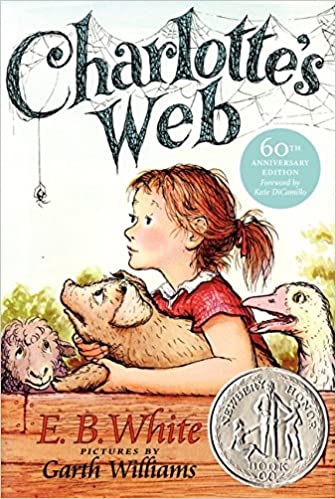
Similarly, he was astonished when I explained what kinds of animals lay eggs (for the Ee unit). I also happen to be pregnant with Baby #4, which he understands and is very excited for, and so we had lots of conversations that taught that humans, dogs, cats, and other animals with fur or hair grow babies in their tummies (like Mommy is doing right now), but chickens, snakes, and sharks lay eggs and the babies grow in those eggs instead. He was honestly so intrigued by the entire thing and we talked and talked and talked about it all week.
I don’t think I captured his mind in quite the same way when we were simply doing whatever fun activity correlated with that letter. Oh, he enjoyed those, yes, but, you know, we traced our feet onto paper and said, “ff-ff-ff-feet!” and then moved on.
This all sounds so simple when you read it here in these little paragraph, but it’s a big deal. I love seeing these lightbulbs go off in his little mind and his imagination just starts running. He’s so curious and interested in anything and everything, and giving his learning that little extra direction and in-depth look into a single topic has made such a huge difference for him.
It’s Fun!
Best of all, Playing Preschool is a lot of fun! I told you that one of the things I liked about this curriculum is that it’s play-based, but more than that, my boys genuinely enjoy doing preschool and its something they always look forward to. The activities are creative and unique enough to be fun and interesting, but also familiar enough for my boys to recognize and build upon.
Overall I really enjoy this curriculum. Yes, I’ve adapted it to meet my own needs, but overall I’d super recommend it to anyone looking to add that extra boost for their young toddler and stimulate their little minds in the very best way.
